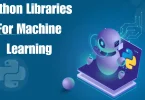Have you ever found yourself confused by the terms AI and machine learning? You’re not alone. Most people casually swap the two as if they mean the same thing—but they don’t. The truth is, while they are closely connected, they are not interchangeable.
In this comprehensive guide, we’ll break down machine learning vs AI key differences, explain how each one works, and explore their real-world impact on your everyday life—from your Netflix suggestions to futuristic self-driving cars.
Let’s dive in.
What Is Artificial Intelligence (AI)?

Artificial Intelligence (AI) is the broad science of making machines “smart.” In simpler terms, AI refers to the simulation of human intelligence by machines—especially computer systems.
This includes the ability to:
- Understand human language
- Recognize images or sounds
- Solve problems
- Learn from experience
- Make decisions
Imagine a robot that can play chess, book appointments, or help diagnose diseases. All of this falls under the umbrella of AI.
AI systems may use pre-programmed rules (like logic trees) or learn from patterns in data. Either way, the goal is the same: to perform tasks that normally require human intelligence.
What Is Machine Learning (ML)?
Machine learning, on the other hand, is a subset of AI. It focuses specifically on developing algorithms that allow computers to learn from data and improve automatically over time—without being explicitly told what to do.
In other words, machine learning allows a system to:
- Identify patterns
- Make predictions
- Improve performance with more data
Here’s a real-world example: when you shop online and get product recommendations based on what you previously bought or clicked—that’s machine learning in action.
Machine Learning vs AI – Key Differences
So what exactly are the machine learning vs AI – key differences? Let’s break it down clearly:
| Aspect | Artificial Intelligence (AI) | Machine Learning (ML) |
| Definition | The science of simulating human intelligence in machines | A subset of AI that allows machines to learn from data |
| Goal | Mimic human thinking and behavior | Use data to improve performance and accuracy |
| Approach | Can be rule-based or data-driven | Completely data-driven |
| Scope | Broad (includes ML, robotics, NLP, expert systems) | Narrower focus within AI |
| Learning Capability | May or may not involve learning | Learning is essential |
| Real-Life Examples | Siri, self-driving cars, chatbots, facial recognition | Email spam filters, Netflix recommendations, fraud detection |
To put it simply:
AI is the goal – to build machines that are intelligent.
Machine learning is a method – one of the ways we achieve that goal.
Real-World Applications of AI and ML

Now that we understand the machine learning vs AI – key differences, let’s look at how both are used in the real world:
1. Healthcare
- AI: Helps doctors make decisions, analyze imaging data, and assist with surgeries.
- ML: Predicts diseases from patient data (e.g., early cancer detection using MRI scans).
2. Finance
- AI: Automates financial operations and customer support.
- ML: Detects credit card fraud, predicts stock trends based on historical data.
3. Retail & E-commerce
- AI: Powers chatbots and virtual assistants.
- ML: Recommends products, analyzes customer behavior to improve marketing strategies.
4. Transportation
- AI: Manages traffic patterns, powers self-driving vehicles.
- ML: Learns driver behavior, predicts routes based on past driving data.
Future Trends in Machine Learning vs AI – Key Differences to Watch
As technology continues to evolve, so will our understanding of machine learning vs AI – key differences. Here’s what’s on the horizon:
- More human-like AI: Future AI systems may mimic not just our logic, but also emotions and creativity.
- Self-learning AI: ML algorithms that can learn with less human intervention (also known as unsupervised or reinforcement learning).
- AI and ML fusion in robotics: Robots will not just follow commands—they’ll learn and adapt to human environments.
- AI ethics and bias reduction: More focus on developing fair, accountable, and transparent AI systems.
These emerging technologies will continue blurring the lines between AI and machine learning—but understanding the core differences now will help you stay informed and ahead.
Why Understanding Machine Learning vs AI – Key Differences Matters
Whether you’re a student, a professional, or just a curious mind, knowing the difference between AI and ML can be incredibly useful.
Here’s why:
- Career opportunities: Roles like AI engineer, ML engineer, and data scientist are in high demand.
- Better decision-making: In tech, business, and even healthcare, understanding these tools helps you make smarter choices.
- Everyday awareness: From your smartphone to your streaming service, AI and ML touch nearly every aspect of modern life.
You may also like to read this:
Smartwatch Reviews Which Is Best Top Picks For 2025 Buyers
5 Best Smartphones Under ₹25000 In 2025 For Gamers
How To Create A Strong Password That’s Secure And Easy
Realme Vs Samsung Budget Phone Review: Full Comparison
Best Tablets For Reading And Work: 2025’s Top 5 Compared
Beginner Guide: What Is Machine Learning In Simple Words?
Machine Learning vs AI – Key Differences in Development Approach
Another essential layer to understanding machine learning vs AI – key differences lies in how they are developed and used in real-world software systems.
1. Development Style
- AI systems can be rule-based (like if-then statements) or logic-driven, often requiring manual input of logic to simulate reasoning and decision-making.
- Machine learning systems, in contrast, are data-driven. They don’t need fixed rules—they figure out what to do by finding patterns in huge datasets.
For example:
- AI for chess might include predefined strategies.
- ML for chess would learn strategies by playing thousands of games.
2. Human Involvement
- In AI development, humans often program rules and logic to guide behavior.
- In machine learning, humans collect, clean, and label data—but the system finds the logic on its own.
Choosing Between AI and Machine Learning in Projects
If you’re a business leader, developer, or student working on a project, understanding machine learning vs AI – key differences helps in choosing the right approach.
Ask yourself:
- Do you want a system to make decisions based on complex, logical rules? → Go with AI.
- Do you have lots of data and want the system to learn from it? → Choose machine learning.
For example:
- A chatbot that answers basic questions → likely AI with rule-based logic.
- A system that recommends products based on user behavior → definitely machine learning.
Learning Path: Mastering Machine Learning and AI
Now that we’ve thoroughly explored machine learning vs AI – key differences, here’s a quick roadmap to help you dive into these technologies.
Step-by-Step Learning Guide:
- Start with Python
- Tools: Codecademy, W3Schools, or freeCodeCamp
- Why? It’s the language of choice in both AI and ML.
- Tools: Codecademy, W3Schools, or freeCodeCamp
- Understand AI Concepts
- Learn logic, decision trees, search algorithms, and knowledge representation.
- Recommended Course: CS50’s Introduction to AI with Python (Harvard)
- Learn logic, decision trees, search algorithms, and knowledge representation.
- Master Machine Learning Fundamentals
- Learn supervised, unsupervised, and reinforcement learning.
- Recommended Course: Machine Learning by Andrew Ng (Coursera)
- Learn supervised, unsupervised, and reinforcement learning.
- Work on Projects
- Build spam filters, recommendation engines, or prediction models.
- Use tools like scikit-learn, TensorFlow, and PyTorch.
- Build spam filters, recommendation engines, or prediction models.
- Stay Updated
- Follow AI news, research papers (like from arXiv), and communities (Reddit, Stack Overflow, Kaggle).
Understanding machine learning vs AI – key differences early on helps you choose the right learning path depending on whether you’re more interested in logic-driven systems or data-driven models.
Additional Resources to Deepen Your Understanding
If you’re serious about mastering the machine learning vs AI – key differences and applying them in your life or career, here are some curated resources:
Beginner Courses:
- AI for Everyone – Andrew Ng (Coursera)
Best for: Beginners who want to understand what AI is and how it affects society. - Machine Learning – Andrew Ng (Coursera)
Best for: Learning the core machine learning models (linear regression, decision trees, etc.).
Books:
- “Artificial Intelligence: A Guide for Thinking Humans” by Melanie Mitchell
- “Hands-On Machine Learning with Scikit-Learn, Keras & TensorFlow” by Aurélien Géron
Practice Platforms:
- Kaggle: Learn and practice machine learning with real datasets.
- Google Colab: Run ML notebooks in the cloud without setup.
Glossary of Key Terms
Before we fully wrap up, here’s a quick glossary to help you lock in the core concepts related to machine learning vs AI – key differences:
- Artificial Intelligence (AI): A broad field in computer science focused on building machines that can simulate human intelligence.
- Machine Learning (ML): A subset of AI where machines learn from data to make predictions or decisions without being explicitly programmed.
- Deep Learning: A subfield of ML using neural networks to model complex patterns in data—used in image and speech recognition.
- Supervised Learning: A type of ML where the model learns from labeled data.
- Unsupervised Learning: A type of ML where the model finds patterns in data without labels.
- Natural Language Processing (NLP): An AI field that enables computers to understand, interpret, and respond to human language.
- Neural Network: A computing system inspired by the human brain’s structure, used heavily in ML and AI.
Having this glossary at your fingertips makes technical conversations and research a lot smoother!
Call to Action: Your Next Step After Learning Machine Learning vs AI – Key Differences
You’ve now built a strong understanding of machine learning vs AI – key differences—but don’t stop here. This knowledge is the foundation of countless future innovations.
Here’s what you can do next:
Join a free AI or ML course
Start a beginner ML project—like image classification or spam detection
Follow AI/ML news to stay updated
Discuss what you’ve learned with peers or on platforms like Reddit or LinkedIn
Most importantly, keep asking questions, exploring, and experimenting. The more hands-on you get, the clearer and more exciting this world becomes.
Conclusion
By now, you’ve seen that machine learning vs AI key differences go far beyond buzzwords. While AI is the broader goal of building intelligent systems that simulate human behavior, machine learning is the engine that often powers this intelligence through data-driven learning.
Understanding this distinction isn’t just for tech experts—it’s essential knowledge for anyone living in the digital age. Whether you’re streaming a show, shopping online, using voice assistants, or considering a career in tech, AI and machine learning are silently shaping your world.
Here’s the simple takeaway:
- AI is the umbrella concept aiming to create smart machines.
- Machine learning is a specific tool within that umbrella that helps machines learn from experience.
As innovation accelerates, these technologies will only become more integrated into daily life and work. Knowing the machine learning vs AI – key differences gives you clarity, confidence, and the curiosity to keep exploring.
So, whether you’re just beginning your learning journey or ready to build the next big thing, this foundational understanding is your first real step into the future of intelligent technology.
FAQs
1. Are AI and machine learning the same thing?
No, they are not the same.
While they are closely related, AI (Artificial Intelligence) is the broader concept of machines performing tasks that mimic human intelligence. Machine learning is a subset of AI that allows machines to learn from data without being explicitly programmed. Understanding the machine learning vs AI – key differences helps clarify how these terms relate but are not interchangeable.
2. What is the main difference between AI and machine learning?
The main difference is their scope and approach:
AI aims to simulate human intelligence in machines, using both rule-based and data-driven techniques.
Machine learning, on the other hand, is specifically focused on systems that learn from data to improve performance over time.
In short, AI is the goal, and machine learning is one of the ways to reach it.
3. Can AI work without machine learning?
Yes, it can.
AI systems can be built using rule-based logic or expert systems that don’t rely on learning from data. However, most modern AI applications use machine learning because it allows systems to improve automatically and adapt to new information.
This is one of the key distinctions in understanding machine learning vs AI – key differences in practical applications.
4. Is deep learning the same as machine learning?
Deep learning is a subset of machine learning. It uses artificial neural networks inspired by the human brain to process data and make decisions. While traditional machine learning relies on structured data, deep learning excels at handling unstructured data like images, videos, and audio.
5. What are some examples that highlight machine learning vs AI – key differences?
Here are a few real-world examples:
AI: A self-driving car deciding when to stop or accelerate based on road rules and surroundings.
ML: The same car improving its performance by learning from driving data (e.g., identifying pedestrians more accurately over time).
Another example:
AI: A chatbot responding to customer queries based on pre-written scripts.
ML: A recommendation system learning your preferences based on your browsing or purchase history.




